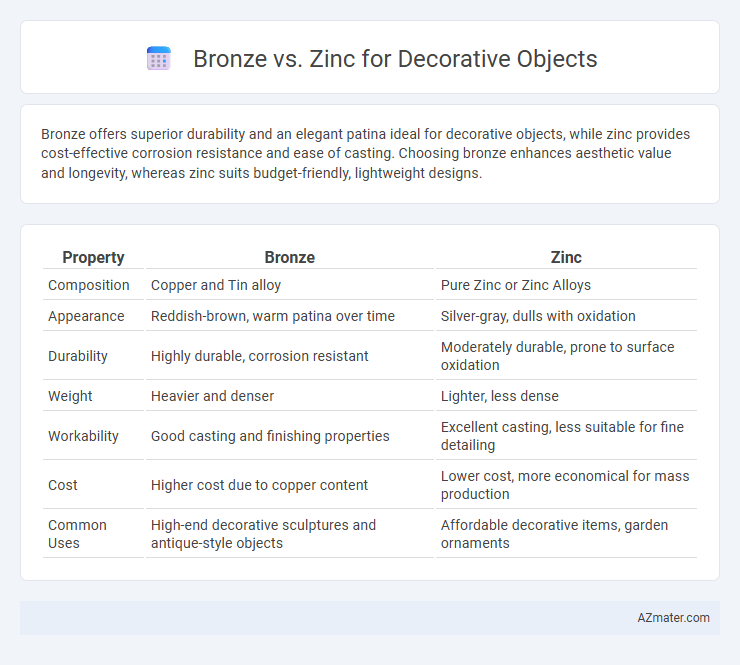Bronze offers superior durability and an elegant patina ideal for decorative objects, while zinc provides cost-effective corrosion resistance and ease of casting. Choosing bronze enhances aesthetic value and longevity, whereas zinc suits budget-friendly, lightweight designs.
Table of Comparison
| Property | Bronze | Zinc |
|---|---|---|
| Composition | Copper and Tin alloy | Pure Zinc or Zinc Alloys |
| Appearance | Reddish-brown, warm patina over time | Silver-gray, dulls with oxidation |
| Durability | Highly durable, corrosion resistant | Moderately durable, prone to surface oxidation |
| Weight | Heavier and denser | Lighter, less dense |
| Workability | Good casting and finishing properties | Excellent casting, less suitable for fine detailing |
| Cost | Higher cost due to copper content | Lower cost, more economical for mass production |
| Common Uses | High-end decorative sculptures and antique-style objects | Affordable decorative items, garden ornaments |
Introduction to Bronze and Zinc for Decorative Objects
Bronze, an alloy primarily composed of copper and tin, offers exceptional durability and a warm, brownish-gold patina that enhances decorative objects over time. Zinc, a bluish-gray metal, is valued for its corrosion resistance and affordability, often used in decorative pieces requiring lightweight and intricate designs. Both metals provide unique aesthetic and functional qualities, with bronze favored for its classic appeal and zinc for its versatility and modern finish.
Composition and Properties of Bronze
Bronze is an alloy primarily composed of copper and tin, often containing small amounts of other metals such as aluminum or phosphorus, which enhance its strength and corrosion resistance. Its higher hardness and excellent durability compared to zinc make bronze ideal for decorative objects requiring long-term wear and intricate detailing. The warm, reddish-brown hue of bronze also provides an aesthetically pleasing appearance that ages gracefully with a unique patina.
Composition and Properties of Zinc
Zinc is a bluish-white metal composed primarily of the element Zn with trace amounts of aluminum, copper, and magnesium to enhance strength and corrosion resistance. Zinc's low melting point and excellent anti-corrosive properties make it ideal for coating and die-casting decorative objects, offering durability and resistance to environmental degradation. Compared to bronze, zinc is lighter and more cost-effective, but it has lower tensile strength and may be more prone to surface oxidation without protective coatings.
Aesthetic Appeal: Bronze vs Zinc
Bronze offers a warm, rich patina that deepens with age, enhancing the aesthetic appeal of decorative objects through its classic and timeless look. Zinc provides a sleek, modern finish with a subtle grayish tone that resists corrosion and maintains a consistent appearance over time. The choice between bronze and zinc depends on whether a traditional, antique style or a contemporary, minimalist design is preferred for decorative purposes.
Durability and Longevity Comparison
Bronze exhibits superior durability compared to zinc due to its higher resistance to corrosion and wear, making it ideal for long-lasting decorative objects exposed to the elements. Zinc, while more affordable and lightweight, tends to oxidize and degrade faster, reducing its longevity in outdoor applications. Preservation of bronze's patina over time enhances its aesthetic and protective qualities, contributing to greater lifespan than zinc counterparts.
Cost Considerations: Bronze vs Zinc
Bronze typically costs more than zinc due to its higher copper content and more complex alloy composition, impacting budget decisions for decorative objects. Zinc offers a more affordable option with lower raw material and production costs, making it ideal for large-scale or cost-sensitive projects. The choice between bronze and zinc often balances material expense against desired durability and aesthetic quality.
Maintenance and Care Requirements
Bronze requires regular cleaning to prevent oxidation and develop a desirable patina, often needing gentle polishing with specialized wax or oils to maintain its luster. Zinc is more resistant to corrosion and requires less frequent maintenance, typically only needing occasional wiping to remove dust and prevent surface dulling. Both metals benefit from avoiding harsh chemicals, but bronze demands more attentive care to preserve its aesthetic appeal over time.
Suitability for Indoor and Outdoor Use
Bronze offers superior durability and corrosion resistance, making it ideal for both indoor and outdoor decorative objects exposed to weather elements. Zinc provides excellent resistance to rust and requires less maintenance, well-suited for outdoor settings but can develop a protective patina over time indoors. For long-lasting aesthetic appeal in diverse environments, bronze often outperforms zinc in terms of strength and longevity.
Popular Decorative Objects Made from Bronze and Zinc
Bronze is widely used for decorative objects such as statues, plaques, and antique-style lamps due to its durability and classic warm patina. Zinc is favored for garden ornaments, hardware, and architectural details because it is lightweight, corrosion-resistant, and allows intricate casting. Popular bronze items often include historical replicas and sculptures, while zinc is commonly chosen for detailed finials and decorative hardware.
Choosing the Right Metal for Your Decorative Needs
Bronze offers a warm, classic patina and superior durability, making it ideal for outdoor decorative objects exposed to weathering. Zinc provides a lightweight, corrosion-resistant option with excellent moldability, suited for intricate indoor designs requiring fine detail. Consider bronze for longevity and a timeless look, while zinc excels in budget-friendly, detailed decorative pieces.

Infographic: Bronze vs Zinc for Decorative Object
 azmater.com
azmater.com